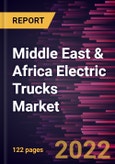The MEA electric trucks market is expected to grow from US$ 284.43 million in 2022 to US$ 959.13 million by 2028. It is estimated to grow at a CAGR of 22.5% from 2022 to 2028.
The electric trucks market is growing due to the rising trend of self-driving trucks. Autonomous driving and electromobility are key fields for the transport sector's future. There are plenty of examples of applications for both fields, whether trucks, cars, buses, or even construction machinery, such as excavators and wheel loaders. However, linking the two remains the exception, even though this fusion offers the greatest potential economically and ecologically, especially in the truck and transport sector. Top original equipment manufacturers (OEM), such as Tesla, Volvo, Vera, and Daimler, have developed self-driving electric trucks. Startups, including Embark, Einride, TuSimple, and Ike (Nuro), have also started developing self-driving electric trucks. Waymo had started testing its self-driving trucks. Self-driving electric truck technology will create market opportunities for electric truck manufacturers in the long run due to the various advantages, such as easy use and the presence of value-added features.
With new features and technologies, vendors can attract new customers and expand their footprints in emerging markets. This factor is likely to drive the MEA electric trucks market at a promising CAGR during the forecast period.
The electric trucks market is growing due to the rising trend of self-driving trucks. Autonomous driving and electromobility are key fields for the transport sector's future. There are plenty of examples of applications for both fields, whether trucks, cars, buses, or even construction machinery, such as excavators and wheel loaders. However, linking the two remains the exception, even though this fusion offers the greatest potential economically and ecologically, especially in the truck and transport sector. Top original equipment manufacturers (OEM), such as Tesla, Volvo, Vera, and Daimler, have developed self-driving electric trucks. Startups, including Embark, Einride, TuSimple, and Ike (Nuro), have also started developing self-driving electric trucks. Waymo had started testing its self-driving trucks. Self-driving electric truck technology will create market opportunities for electric truck manufacturers in the long run due to the various advantages, such as easy use and the presence of value-added features.
With new features and technologies, vendors can attract new customers and expand their footprints in emerging markets. This factor is likely to drive the MEA electric trucks market at a promising CAGR during the forecast period.
MEA Electric Trucks Market Segmentation
The MEA electric trucks market is segmented on the basis of propulsion type, vehicle type, range, level of automation, and country.- Based on propulsion, the market is segmented into BEV, FCV, and PHEV. The BEV segment is the dominant one in 2022 and is expected to be the fastest-growing segment during the forecast period.
- Based on vehicle type, the market is bifurcated into LCVs and medium & HCVs. The LCV segment is the dominant one in 2022 and is expected to be the fastest-growing segment during the forecast period.
- Based on range, the market is segmented into less than 200 miles and more than 200 miles. The more than 200 miles segment has emerged as the dominating one in 2022 and is expected to be the fastest-growing segment during the forecast period.
- Based on level of automation, the market is segmented into semi-autonomous and fully autonomous. The fully autonomous segment has been dominant in 2022 and is expected to be the fastest-growing segment during the forecast period.
- Based on country, the regional market is segmented into South Africa, Saudi Arabia, the UAE, and the Rest of the MEA.
Table of Contents
1. Introduction
3. Research Methodology
4. MEA Electric Trucks Market Landscape
5. MEA Electric Trucks Market - Key Market Dynamics
6. MEA Electric Trucks Market Analysis
7. MEA Electric Trucks Market Revenue and Forecast to 2028 - Type
8. Electric Trucks Market - By Vehicle Type
9. MEA Electric Trucks Market - By Range
10. MEA Electric Trucks Market - By Level of Automation
11. MEA Electric Trucks Market -Country Analysis
12. Industry Landscape
13. Company Profile
14. Appendix
Companies Mentioned (Partial List)
A selection of companies mentioned in this report includes, but is not limited to:
- AB Volvo
- aimler AG
- FAW Group Co., Ltd
- Navistar, Inc.
- PACCAR Inc.
- Proterra Inc.
- Rivian
- Scania
- Tesla, Inc.
Table Information
| Report Attribute | Details |
|---|---|
| No. of Pages | 122 |
| Published | September 2022 |
| Forecast Period | 2022 - 2028 |
| Estimated Market Value ( USD | $ 284.43 Million |
| Forecasted Market Value ( USD | $ 959.13 Million |
| Compound Annual Growth Rate | 22.5% |
| Regions Covered | Africa, Middle East |








